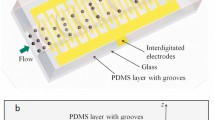Abstract
Focusing and ordering of micro- or nanoparticles is an essential ability in microfluidic platforms for bio-sample processing. Hydrophoresis is an effective method utilising hydrodynamic force to focus microparticles, but it is limited by the fixed operational range and the lack of flexibility. Here, we report a work to tune and improve the dynamic range of hydrophoresis device using magnetophoresis. In this work, a novel approach was presented to fabricate the lateral fluidic ports, which allow the flipped chip to remain stable on the stage of microscope. Diamagnetic polystyrene microparticles suspended in a ferrofluidic medium were repelled to the lower level of the channel by negative magnetophoretic force, and then interact with grooves of microchannel to obtain an excellent hydrophoretic ordering. The effects of (i) flow rate, (ii) particle size, (iii) magnetic susceptibility of the medium, and (iv) number of magnets on the particle focusing efficiency were also reported. As the proposed magnetophorsis-assisted hydrophoretic device is tuneable and simple, it holds great potential to be integrated with other microfluidic components to form an integrated sample-to-answer system.






Similar content being viewed by others
References
P.B. áHowell Jr et al., Two simple and rugged designs for creating microfluidic sheath flow. Lab Chip 8(7), 1097–1103 (2008)
S. Choi et al., Continuous blood cell separation by hydrophoretic filtration. Lab Chip 7(11), 1532–1538 (2007)
S. Choi et al., Sheathless hydrophoretic particle focusing in a microchannel with exponentially increasing obstacle arrays. Anal. Chem. 80(8), 3035–3039 (2008a)
S. Choi et al., Sheathless focusing of microbeads and blood cells based on hydrophoresis. Small 4(5), 634–641 (2008b)
S. Choi et al., Tuneable hydrophoretic separation using elastic deformation of poly(dimethylsiloxane). Lab Chip 9(13), 1962–1965 (2009a)
S. Choi et al., Hydrophoretic sorting of micrometer and submicrometer particles using anisotropic microfluidic obstacles. Anal. Chem. 81(1), 50–55 (2009b)
S. Choi et al., Microfluidic self-sorting of mammalian cells to achieve cell cycle synchrony by hydrophoresis. Anal. Chem. 81(5), 1964–1968 (2009c)
S. Choi et al., Hydrophoretic high-throughput selection of platelets in physiological shear-stress range. Lab Chip 11(3), 413–418 (2011)
P.J. Crosland-Taylor, A device for counting small particles suspended in a fluid through a tube. Nature 171(4340), 37–38 (1953)
T.P. Forbes et al., Microfluidic magnetophoretic separations of immunomagnetically labeled rare mammalian cells. Lab Chip 12(8), 1471–1479 (2012)
J.P. Golden et al., Multi-wavelength microflow cytometer using groove-generated sheath flow. Lab Chip 9(13), 1942–1950 (2009)
M. Hejazian et al., Lab on a chip for continuous-flow magnetic cell separation. Lab Chip 15(4), 959–970 (2015)
H. Kawaguchi, Functional polymer microspheres. Prog. Polym. Sci. 25(8), 1171–1210 (2000)
J.S. Kim et al., Multiplexed detection of bacteria and toxins using a microflow cytometer. Anal. Chem. 81(13), 5426–5432 (2009)
A.R. Kose et al., Label-free cellular manipulation and sorting via biocompatible ferrofluids. Proc. Natl. Acad. Sci. U. S. A. 106(51), 21478–21483 (2009)
M. Li, et al., Continuous particle focusing in a waved microchannel using negative dc dielectrophoresis. J. Micromech.Microeng. 22(9): 095001 (2012)
B. Massey, Mechanics of Fluids (Chapman Hall, London, 1989)
N. Pamme et al., Continuous sorting of magnetic cells via on-chip free-flow magnetophoresis. Lab Chip 6(8), 974–980 (2006)
S.A. Peyman et al., Diamagnetic repulsion—a versatile tool for label-free particle handling in microfluidic devices. J. Chromatogr. A 1216(52), 9055–9062 (2009)
B. D. Plouffe, et al., Computational design optimization for microfluidic magnetophoresis. Biomicrofluid. 5(1): 013413 (2011)
D. Robert et al., Cell sorting by endocytotic capacity in a microfluidic magnetophoresis device. Lab Chip 11(11), 1902–1910 (2011)
A.I. Rodriguez-Villarreal et al., Flow focussing of particles and cells based on their intrinsic properties using a simple diamagnetic repulsion setup. Lab Chip 11(7), 1240–1248 (2011)
F. Shen et al., Label-free cell separation using a tunable magnetophoretic repulsion force. Anal. Chem. 84(7), 3075–3081 (2012)
Y. Sheng, et al., An integrated dielectrophoresis-active hydrophoretic microchip for continuous particle filtration and separation. J. Micromech. Microeng. 25(8): 084010 (2015)
S. Song et al., Smart microfluidic pipette tip enabled by flow-rate insensitive particle ordering. Small 10(20), 4123–4129 (2014)
W.-H. Tan et al., A trap-and-release integrated microfluidic system for dynamic microarray applications. Proc. Natl. Acad. Sci. U. S. A. 104(4), 1146–1151 (2007)
A.L. Thangawng et al., A hard microflow cytometer using groove-generated sheath flow for multiplexed bead and cell assays. Anal. Bioanal. Chem. 398(5), 1871–1881 (2010)
S. Yan et al., Isolating plasma from blood using a dielectrophoresis-active hydrophoretic device. Lab Chip 14(16), 2993–3003 (2014a)
S. Yan, et al., Making a hydrophoretic focuser tunable using a diaphragm. Biomicrofluid. 8(6): 064115 (2014b)
S. Yan et al., On-chip high-throughput manipulation of particles in a dielectrophoresis-active hydrophoretic focuser. Sci. Rep. 4, 5060 (2014c)
S. Yan et al., A hybrid dielectrophoretic and hydrophoretic microchip for particle sorting using integrated prefocusing and sorting steps. Electrophoresis 36(2), 284–291 (2015)
T. Zhu et al., Focusing microparticles in a microfluidic channel with ferrofluids. Microfluid. Nanofluid. 11(6), 695–701 (2011)
T. Zhu et al., Combining positive and negative magnetophoreses to separate particles of different magnetic properties. Microfluid. Nanofluid. 17(6), 973–982 (2014)
Acknowledgments
This work is supported by the University of Wollongong -China Scholarship Council joint scholarships and the CSIRO Office of Chief Executive (OCE) Top-up Scholarship.
Author information
Authors and Affiliations
Corresponding authors
Electronic supplementary material
Below is the link to the electronic supplementary material.
ESM 1
(DOC 212 kb)
Rights and permissions
About this article
Cite this article
Yan, S., Zhang, J., Chen, H. et al. Development of a novel magnetophoresis-assisted hydrophoresis microdevice for rapid particle ordering. Biomed Microdevices 18, 54 (2016). https://doi.org/10.1007/s10544-016-0078-7
Published:
DOI: https://doi.org/10.1007/s10544-016-0078-7




